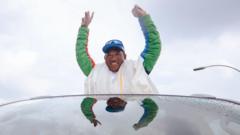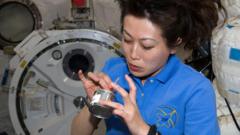In a significant milestone for China's space program, two astronauts aboard the Shenzhou-19 mission recently completed a spacewalk lasting nine hours, according to the Chinese Manned Space Agency. This achievement marks the longest recorded time spent outside a spacecraft, narrowly edging past the previous record of eight hours and 56 minutes set by American astronauts in 2001.
Chinese Astronauts Achieve Record-Breaking Spacewalk

Chinese Astronauts Achieve Record-Breaking Spacewalk
Two astronauts reportedly spend over nine hours outside the Tiangong Space Station, surpassing a long-standing spacewalk record previously held by Americans.
The astronauts, Cai Xuzhe and Song Lingdong, undertook this extravehicular activity (EVA) to conduct essential maintenance and installation of equipment on the Tiangong Space Station, enhancing its protective measures against space debris. Mr. Song expressed a sense of awe and responsibility in their contribution to manned space exploration after their lengthy excursion into the vacuum of space.
Launching in late October, the Shenzhou-19 crew consists of three astronauts, including engineer Wang Haoze, who remained inside the station during the spacewalk, providing support. The astronauts' mission to the Tiangong Space Station is set to last six months, during which they will conduct multiple spacewalks and experiments.
The historical context of spacewalks traces back to 1965, beginning with a brief 16-minute EVA conducted by a Soviet astronaut. China's journey in this domain began in 2008 with a 19-minute excursion. Though the record for the longest spacewalk is still pending international validation, the Chinese Manned Space Agency has made it clear that this achievement marks a first for China's astronauts.
In addition to exploring space, the crew is also conducting biological experiments in microgravity, including research on fruit flies to understand their behavior under varying magnetic conditions and weightlessness. This research is anticipated to contribute vital insights into life sciences as China strengthens its presence in space exploration.
Chris Buckley, The Times' chief correspondent from Taipei, covers critical issues facing China and Taiwan, including political dynamics and security matters.
Launching in late October, the Shenzhou-19 crew consists of three astronauts, including engineer Wang Haoze, who remained inside the station during the spacewalk, providing support. The astronauts' mission to the Tiangong Space Station is set to last six months, during which they will conduct multiple spacewalks and experiments.
The historical context of spacewalks traces back to 1965, beginning with a brief 16-minute EVA conducted by a Soviet astronaut. China's journey in this domain began in 2008 with a 19-minute excursion. Though the record for the longest spacewalk is still pending international validation, the Chinese Manned Space Agency has made it clear that this achievement marks a first for China's astronauts.
In addition to exploring space, the crew is also conducting biological experiments in microgravity, including research on fruit flies to understand their behavior under varying magnetic conditions and weightlessness. This research is anticipated to contribute vital insights into life sciences as China strengthens its presence in space exploration.
Chris Buckley, The Times' chief correspondent from Taipei, covers critical issues facing China and Taiwan, including political dynamics and security matters.














